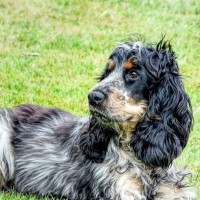Appearance of the Colonial Cocker Spaniel
|
| The standard structure of these dogs will vary according to parental gene dominance, but will include a moderately long, muscular neck and rounded hind legs. Their eyes should be dark and the ears are generally low-set and lobular. The English Cocker Spaniel and the American Cocker Spaniel will have similar physical characteristics. The English version is slightly larger than the American and has a shorter coat. The American Cocker Spaniel also has a steeper stop than the English Cocker Spaniel, as well as shorter muzzles. Their long ears are on round heads, and the coats are feathered. In the English version, the upper lips hang over the lower jaw and teeth that should meet in a scissor bite. The American type has square lips and a snub nose, which will be brown or black, depending on coat color. The eyes are rounded with oval rims, and the paws are cat-like with arched toes. |
Temperament of the Colonial Cocker Spaniel
|
| This hybrid breed is alert and lively. Their friendly, cheerful nature makes them excellent pets. Being gentle and playful, these dogs would do well in a home with children and other pets. This intelligent breed will be easy to train, and its loving personality makes it gentle and affectionate. To teach Spaniels, you'll need to be patient and gentle. Some of these dogs have difficulty mastering fracas. This breed can develop separation anxiety and is therefore happiest with families who can give them affection and don't leave the house empty for long periods. They tend to bark at anything and everything, so teaching them a silent command may be a good idea. As with all breeds, teach the Colonial Cocker Spaniel basic obedience and socialize him properly as a puppy. This will ensure that your dog is calm in public and respectful of your authority. |
Needs and activities of the Colonial Cocker Spaniel
|
| Although the Colonial Cocker Spaniel isn't very big, he'll live best in homes that have an accessible yard for him to run around. Its outdoor play area should be fenced, as this active, inquisitive dog may chase birds or other small creatures. Make sure they get enough exercise, as Colonial Cocker Spaniels can develop anxiety if they're not active enough. They'll enjoy following you on hikes, runs or other activities. |
Maintenance of the Colonial Cocker Spaniel
|
| This breed's coat should be brushed daily and bathed regularly. Some English Cocker Spaniel owners opt for clipping to reduce maintenance. The American Cocker Spaniel should be carefully groomed and trimmed every few months, with regular brushing in between. These dogs have large eyes that will also need regular cleaning. All dogs, but especially Spaniels, with their long, floppy ears, should have them wiped and cleaned regularly. About once a week should be enough to prevent infection. Remember that dogs with long, floppy ears are more prone to problems, so this is an important step. Dogs should also have their teeth brushed about two or three times a week. Daily brushing is the best way to keep teeth and gums healthy. Trim your dog's nails as needed. This can be once or twice a month, but it mainly depends on the dog's activity level, as more active dogs can wear them naturally. |









 English (United Kingdom)
English (United Kingdom)